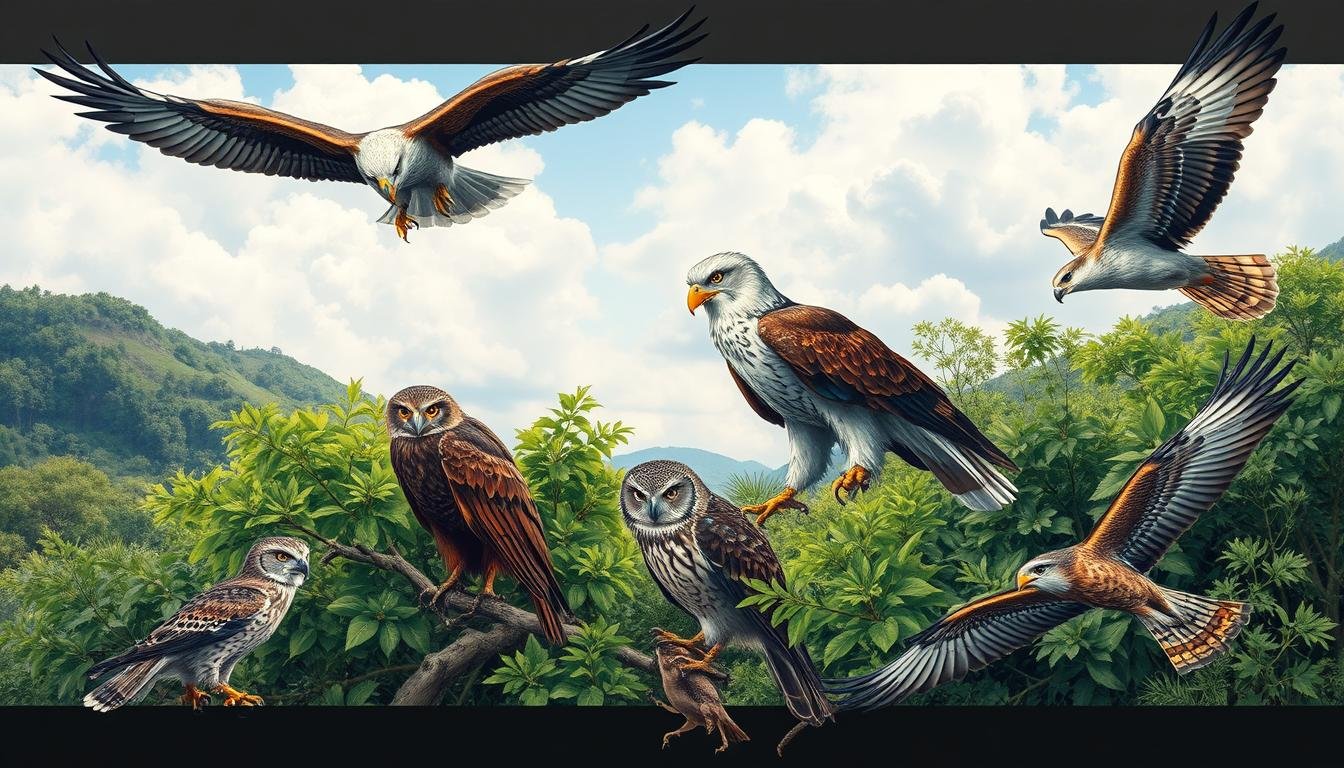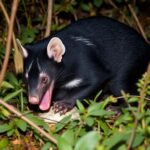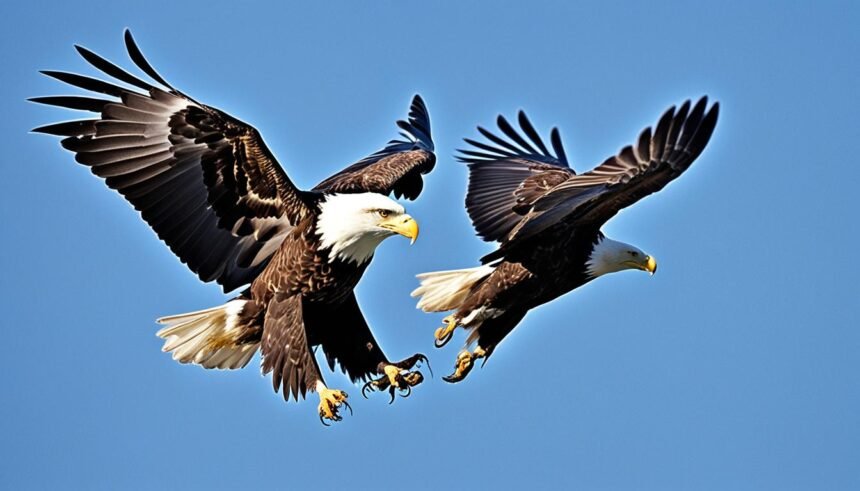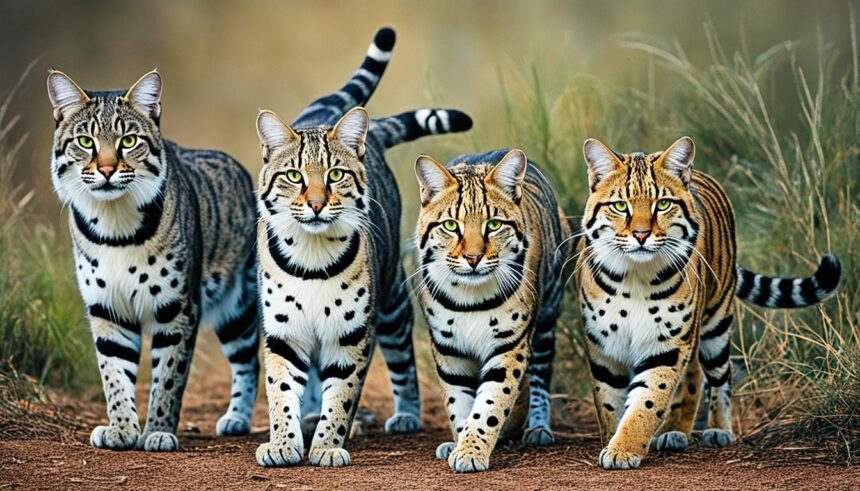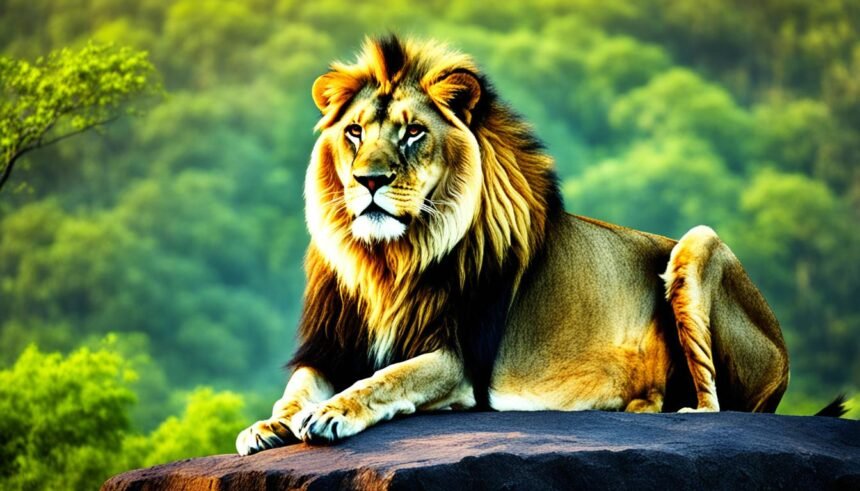Exploring birds of prey is more than a hobby; it’s a dive into a captivating world. Raptors are skilled hunters with sharp eyes and graceful flight. This guide helps you spot and understand these amazing creatures.
Looking up at the northeastern U.S. skies, you might see the Red-tailed Hawk. Or, you might spot a Peregrine Falcon, one of the eastern falcons. Knowing what to look for is crucial. Our guide teaches you to identify birds of prey with ease.
Raptors have strong talons and unique flight patterns. They have incredible eyesight and interesting habits, like regurgitating pellets. This guide will help you understand these sky rulers. It will also deepen your respect for their role in the UK’s ecosystems.
Understanding the Fascinating World of Raptors
Raptors are amazing birds that mix power with grace. They have sharp vision, big wings, and special hunting skills. Let’s dive into what makes them unique, their evolution, and how they hunt.
What Classifies a Bird as a Raptor
Raptors are birds of prey with distinct features. They have strong talons for catching and holding prey. Their hooked bills are perfect for tearing flesh. These traits make them top predators in their habitats.
Evolution and Adaptations of Predatory Birds
Raptors have a long history, with ancestors that ruled the skies and lands. Their sharp vision lets them spot prey from far away. Their large wings allow them to fly for a long time.
From the tiny black-thighed falconet to the huge Andean condor, raptors come in all sizes. Their evolution has helped them thrive in different parts of the world.
The Raptorial Lifestyle: Hunting Skill and Equipment
Raptors have deadly hunting tools. Their strong talons can grip and kill prey. Their hooked bills help tear apart their food.
Every part of a raptor’s body is designed for hunting. Their physical build and instincts make them top predators.
Learning about raptors shows why they’re so admired and studied. Their ability to adapt and evolve is fascinating. The raptorial lifestyle is a true marvel of nature’s design.
Diversity of Diurnal Raptors: From Eagles to Ospreys
“Diurnal raptors” includes birds like hawks, eagles, falcons, kites, and ospreys. They are active during the day. Each species has unique traits for their environment and hunting ways. This makes them amazing additions to biodiversity.
Eagles are big and strong, ruling their habitats. Falcons are fast, diving to catch prey. Ospreys catch fish by diving feet-first. Kites are known for their graceful flight and gliding.
It’s important to know about diurnal raptors for conservation and bird lovers. Here are some key facts about these birds:
| Species Category | Number of Species |
|---|---|
| Hawks | Various |
| Eagles | Various |
| Falcons | Various |
| Ospreys | 1 (with several subspecies) |
| Kites | Various |
Seeing a hawk or an osprey is always exciting. Their behaviors and adaptations show the diversity of life. From forest-dwelling goshawks to falcons on open plains, they adapt to many ecosystems.
By learning about these birds, we value their role in nature. We also see why we must protect them and their homes. This way, future generations can also enjoy these incredible birds.
Characteristics That Help You Spot and Identify Birds of Prey
Learning to identify birds of prey is all about noticing their unique features. It’s important to know their size, shape, and how they fly. This helps us tell one raptor from another. It makes bird watching better and is key for studying birds.
Identifying Raptors by Size and Shape
The size and shape of a bird of prey can tell you a lot. For example, the Andean condor is huge, with a wingspan of nine feet and weighing up to 25 pounds. It’s one of the biggest birds in the sky.
Smaller raptors, like falcons and hawks, are more slender. They have wings that are just the right size for speed. Their strong, sharp talons help them catch prey.
The Role of Plumage Patterns in Raptor Identification
Plumage, or the bird’s feathers, is very important for identifying raptors. Each species has its own colors and patterns. These are especially clear on the underparts when they fly.
For example, ospreys have white underparts and a special crown. These features help us tell them apart from other birds that eat fish. Looking at these differences helps us identify birds correctly.
Flight Patterns: Soaring, Gliding, and Flapping Distinctions
Watching how a raptor flies can also tell you a lot. Vultures glide a lot, which helps them save energy while they look for food. Eagles soar high up in the air, using their wide wings to find thermals.
Falcons, however, flap their wings a lot and dive fast to catch their prey. These different ways of flying show how each bird has adapted to its own way of life.
Decoding Behavioral Clues for Raptor Identification
Understanding raptor behavior is key to identifying them. These birds have adapted to their environments in unique ways. Their behavior, hunting habits, and territories offer clues to their survival strategies.
Raptors often act alone or in pairs, especially when breeding. They fiercely defend their territories. This behavior helps identify species in the field. Their hunting styles also vary, like the Peregrine Falcon’s fast dives and the Red-tailed Hawk’s stalking.
Watching how raptors interact with other birds and their environment is important. Alarm calls and flying behaviors can signal a raptor’s presence. This helps identify the raptor if observed closely.
| Behavior | Habitat Preference | Hunting Method | Common Indicator Species |
|---|---|---|---|
| Solitary vigilance | Open fields, urban high-rises | Stoop dive (fast-paced dive from altitude) | Peregrine Falcon |
| Hovering | Marshes, coastlines | Hover and plunge | Osprey |
| Soaring and gliding | Dense forests, open mountains | Soar and swoop | Golden Eagle |
| Stealth approach | Woodlands, suburban parks | Silent flight and sudden pounce | Cooper’s Hawk |
Young raptors learning to hunt may seem distressed. They call repeatedly or land clumsily. But, these behaviors, along with adult habits, help identify raptors correctly.
Watching raptors, like an Osprey’s dive or a hawk’s silent flight, is crucial. Each species has its own way of adapting to its environment. Noting these behaviors is essential for birdwatchers, researchers, and nature enthusiasts.
Habitats and Regions: Where to Find Birds of Prey Across the UK
The UK is a colorful mix of habitats, each home to different birds of prey. From the coastlines to the uplands, these raptors have found their perfect spots. Knowing where to look is key for birdwatchers and for helping these birds.
In cities, farmland, and heathland, many raptors can be seen. The Common Buzzard, for example, loves the farmland and uplands. It hunts small mammals and carrion there.
Coastal areas are home to Peregrine Falcons, known for their fast dives. Heathlands, though smaller, are vital for the Merlin, the UK’s smallest raptor. It breeds in the sparse vegetation.
Here’s a list of notable birds of prey in the UK’s habitats:
| Species | Estimated Breeding Pairs | Preferred Habitat |
|---|---|---|
| Red Kite | 4,600 | Farmland, upland |
| Sparrowhawk | 31,000 | Woodlands, urban green spaces |
| Peregrine Falcon | 1,750 | Upland regions, coastal cliffs |
| Osprey | 200-250 | Lakes, coastlines |
| Common Buzzard | 63,000 | Farmland, heathland |
| Kestrel | 46,000 | Open country, farmland, urban areas |
| Goshawk | 620 | Forested areas, woodlands |
| Merlin | 1,500 | Heathland, coastal grasslands |
| Tawny Owl | 50,000 | Woodlands, forested urban areas |
Different habitats across the UK let bird lovers see these birds in various settings. This also helps in their conservation. By visiting these places, people can enjoy and help protect the UK’s birds of prey.
The Topography of Raptor Wings and Its Identification Signals
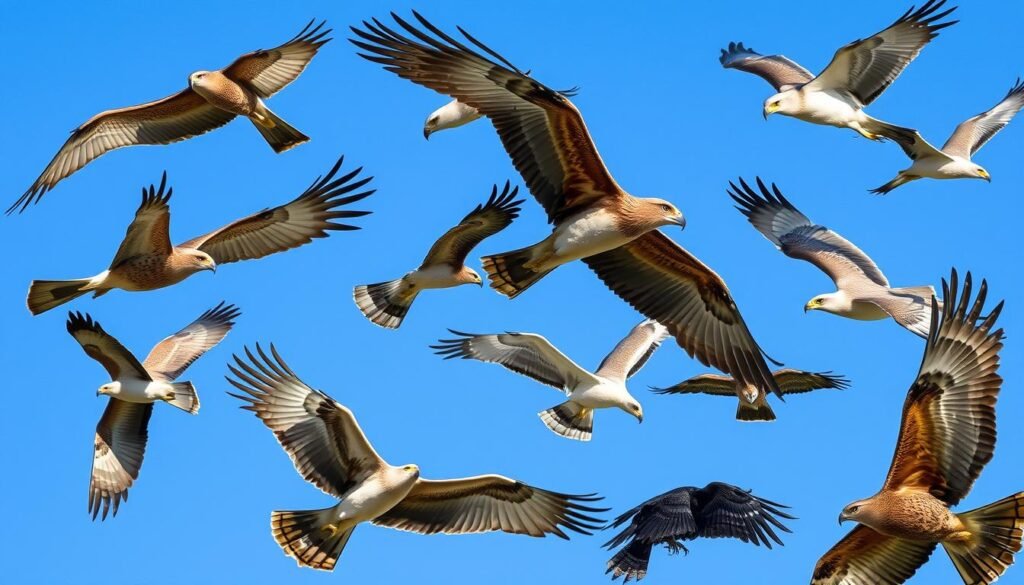
Raptor wings are key to identifying these birds during hawkwatching. The differences in wingspan and wingtips help spot various flying raptors in the sky.
Wingspans and Wing Shapes Across Species
Each raptor has unique wings for flying and hunting. For example, buzzards have broad wings for soaring. Falcons have pointed wings for speed and agility.
Kites have forked tails for quick turns. These features help them survive and are important for hawkwatching.
Flight Feather Configuration and Its Relevance
Raptors have different flight feather setups. These affect how they fly. Hawks, for instance, have wingtips that help them fly through forests.
Using binoculars to see these details helps birdwatchers identify raptors accurately.
| Feature | Description | Example Species |
|---|---|---|
| Wingspan | Length from one wingtip to another | Buzzard, Eagle |
| Forked Tail | Tail that splits into two distinct parts | Kites |
| Flight Feathers | Primary feathers crucial for flight | Hawks, Falcons |
Learning about raptor wings makes hawkwatching more rewarding. It lets us see the amazing adaptations these birds have in different places.
Birds of Prey Identification Guide: Key Species to Know
Some birds of prey stand out for their unique features and behaviors. This guide will focus on key eagles, vultures, and falcons. These birds are often the main subjects for identification by both enthusiasts and professionals.
Eagles: Majestic and Soaring Predators
Eagles are known for their large size and strong build. The golden eagle and the bald eagle are especially notable. They symbolize freedom and strength.
These birds have wingspans over 7 feet, dominating the skies. The white-tailed eagle is recognized by its large white tail and dark body.
Vultures: Misunderstood Scavengers
Vultures are often misunderstood because they eat carrion. But they play a key role in cleaning up carcasses and preventing disease. They are great at soaring and have broad wings and short tail feathers.
Falcons: The Dashing High-Speed Hunters
Falcons, like the peregrine falcon, the kestrel, and the Merlin, are known for their speed and agility. The peregrine falcon is the fastest animal on Earth, diving at speeds up to 200 mph.
Kestrels are smaller and have a playful flight. Merlins are purposeful in their flight, showing their hunting nature.
| Species | Identification Feature | Typical Behavior |
|---|---|---|
| Golden Eagle | Large body, golden nape | Soaring on updrafts, hunting in open areas |
| Bald Eagle | White head and tail, yellow beak | Fishing near lakes and rivers |
| Peregrine Falcon | Blue-grey back, pointed wings, black head | Diving at high speeds to catch birds mid-air |
Knowing these raptors’ unique features and behaviors helps us identify and appreciate their diversity. Seeing them in their natural habitats gives us a glimpse into their ecological roles. It shows how they adapt and survive in different environments.
Spotting Nocturnal Hunters: Owls and Their Unique Traits
Owls are known for their striking looks and silent flight. But did you know they come in many types? The great horned owl has tufted ears and deep hoots. The barn owl has a heart-shaped face and screeches.
The northern hawk owl is different. It hunts during the day but still has sharp hearing and eyesight.
Owls like the barn owl live in open places like grasslands. They use their silent flight to catch rodents. On the other hand, the great horned owl lives in forests and prairies. It’s very adaptable.
But, owls face problems like losing their homes and being harmed by pesticides. This is why we need to keep working to protect them.
The northern hawk owl is special because it hunts both day and night. It loves boreal forests. But, other owls like the burrowing owl are in trouble because of lost homes and pesticides.
It’s important to understand these issues to help save owls. This way, we can keep their habitats safe and their numbers up.
| Species | Population Estimate | Trend | Preferred Habitat | Main Threats |
|---|---|---|---|---|
| Barn Owl | 120,000 | Increasing | Grasslands, Deserts | Habitat Loss, Pesticides |
| Barred Owl | 3,200,000 | Increasing | Mixed Forests | None Noted |
| Burrowing Owl | 1,100,000 | Declining | Grasslands | Habitat Loss, Pesticides, Predators |
| Great Horned Owl | 3,900,000 | Declining | Various Habitats | Pesticides, Illegal Hunting |
| Northern Hawk Owl | Data Not Available | Stable | Boreal Forests | Deforestation |
| Snowy Owl | <30,000 | Declining | Arctic Tundra | Climate Change, Hunting |
Owls in the U.S. and Canada are amazing and face different problems. By learning about them, we can help protect these birds. This way, we can keep our ecosystems healthy and our owls safe.
Raptor Conservation: The Importance of Protecting Birds of Prey
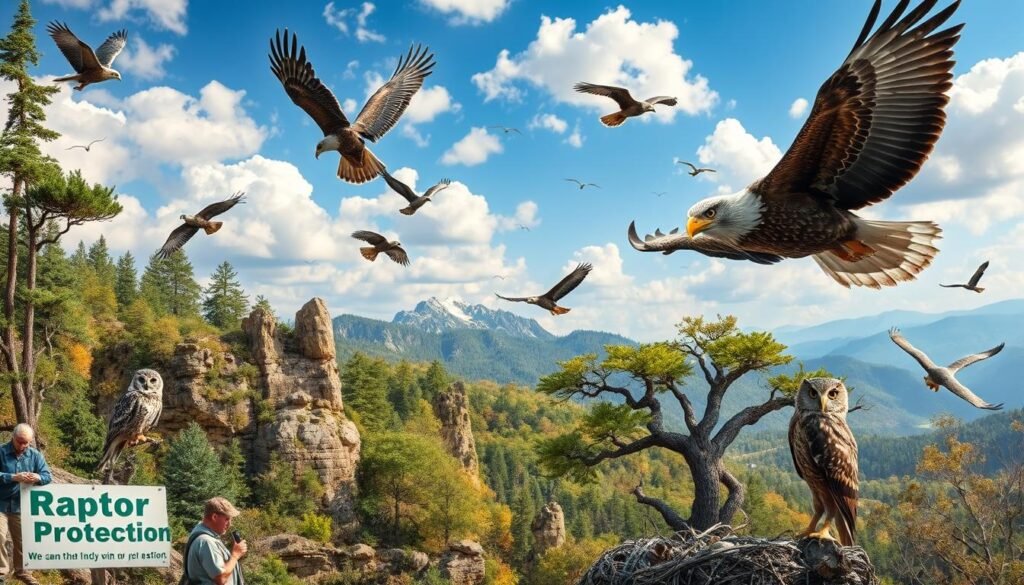
Raptor conservation is key to keeping our ecosystems balanced. Many bird of prey species have declined due to persecution and habitat loss. Thanks to wildlife trusts and habitat restoration, we’re seeing a turnaround.
The Historical Persecution of Raptors and Its Impact
Raptors have long been misunderstood and persecuted. People thought they threatened livestock and competed with game species. This, along with habitat destruction, pushed eagles, hawks, and falcons to the edge of extinction.
Reintroduction and Habitat Restoration Efforts
Reintroduction programs have helped bring back endangered raptors. These efforts include captive breeding and careful releases. Species like the Red-tailed Hawk and Broad-winged Hawk are now more common. Habitat restoration ensures these birds have safe places to live and breed.
The Wildlife Trusts and Raptor Protection Initiatives
The wildlife trusts are vital in protecting raptors. They focus on creating habitats, monitoring populations, and educating the public. Their work is crucial for raptor conservation.
Here’s a look at the conservation status and efforts for different raptors:
| Raptor Species | Wingspan (inches) | Diet | Conservation Effort |
|---|---|---|---|
| Swallow-tailed Kite | 23 | Insects, lizards, snakes, small mammals, birds | Monitored populations and habitat enhancements |
| Mississippi Kite | 14 | Insects, lizards, snakes | Reintroduction in historical ranges |
| Cooper’s Hawk | 16-20 | Small to medium birds, small mammals | Captive breeding and release programs |
| Red-tailed Hawk | 22 | Rodents, snakes, insects, squirrels | Habitat restoration projects |
| Broad-winged Hawk | 13-15 | Snakes, mice, frogs, insects | Protected nesting areas establishment |
Photography and Equipment: Capturing Images for Raptor Identification
Photography is key in identifying raptors. It helps us see the small details needed to tell these birds apart. The right camera gear makes taking pictures of raptors fun and useful for bird guides and conservation.
Choosing the right equipment is vital. You need a camera that shoots fast and a long lens, like 300mm to 800mm. Brands like Olympus and Panasonic offer great Micro Four Thirds cameras. They give high-quality photos from smaller, easier-to-carry devices.
For sharp photos, use a shutter speed of at least 1/2000. Wide aperture lets in more light. Auto ISO helps adjust to changing light. Also, be patient and persistent. Raptors often return to the same spots if they feel safe.
The used market has made photography more affordable. You can find great lenses and camera bodies at lower prices. This makes it easier for newbies to get started.
Places like the Conowingo Dam are great for practicing. It’s full of Bald Eagles. Learning about raptor behaviors, like their hunting and flight, helps improve your photos and identification skills.
Good raptor photos give us deep insights into their lives. They help us understand and protect these important birds.
Conclusion
Our journey through the world of raptors comes to an end, filled with history, identification, and conservation. We learned that many birds of prey were almost wiped out. This guide helps you spot and protect the diverse birds of prey in our skies.
The Raptor Research Foundation’s 2019 study shows the ongoing efforts to save these birds. From Boise to Salt Lake City, people are working hard. Now, when you look up, you can recognize the amazing raptors flying above, like Ospreys or Hawks.
This guide has covered many raptor families, from Accipitriformes to Strigiformes. Resources like “The Crossley ID Guide: Raptors” and “Hawks of North America” have helped us understand these birds. Recent studies, like Wu et al. in 2024, have also deepened our knowledge.
Looking at the data, it’s clear that humans play a big role in the story of these birds. We can help their stories soar, not fall. This guide is a compass for those who want to learn more about raptors and protect them.
FAQ
What are the defining characteristics of a bird of prey?
Birds of prey, or raptors, have sharp vision and strong talons. They also have hooked bills and large wings. These features help them hunt and catch prey like small mammals, birds, and reptiles.
How can I differentiate between diurnal raptor species in flight?
Look at their size, wing shape, and how they fly. Vultures have wide wings and glide a lot. Eagles soar high and flap their wings sometimes.
Falcons and kites have fast wing movements. They also have forked tails.
Are all birds of prey solitary hunters?
Most raptors hunt alone to avoid food competition. But, some may gather in small groups during migration or winter. Watching their behavior helps you identify different species.
Where can I find birds of prey in the UK?
In the UK, you can find them in farmlands, coasts, and upland areas. They also live in heathlands and urban green spaces. Each species prefers a specific environment.
How do reintroduction and habitat restoration efforts benefit birds of prey?
These efforts help raptors recover from persecution and habitat loss. Organizations like The Wildlife Trusts work to create sustainable habitats. This helps raptors thrive and maintain ecological balance.
What equipment is recommended for raptor identification through photography?
Use a camera with a good zoom lens to capture details from afar. Binoculars are also key for spotting raptors. A field guide can help with identification.
What role does the Wildlife Trusts play in raptor conservation?
The Wildlife Trusts are involved in reintroduction and habitat restoration for raptors. They aim to create a network of habitats. This supports a variety of wildlife, including birds of prey.
How can I identify a raptor by its wings and tail in flight?
Wings and tails are key for identifying raptors. Broad wings mean a bird soars, like a buzzard. Pointed wings suggest a faster flyer, like a falcon.
A forked or square tail can also help identify species. For example, a red kite has a forked tail, while a peregrine falcon has a square tail.
Why are plumage patterns important in raptor identification?
Plumage patterns are unique to each raptor species. Coloration, streaks, and bars on the underparts can tell one species apart from another. These details are crucial for birds in flight, where size and behavior can be hard to see.
Can I observe nocturnal birds of prey during the day?
While most nocturnal birds of prey are active at night, some species like the northern hawk owl may be seen during the day. Dawn or dusk is also a good time to see nocturnal species hunting or returning to their roosts.

